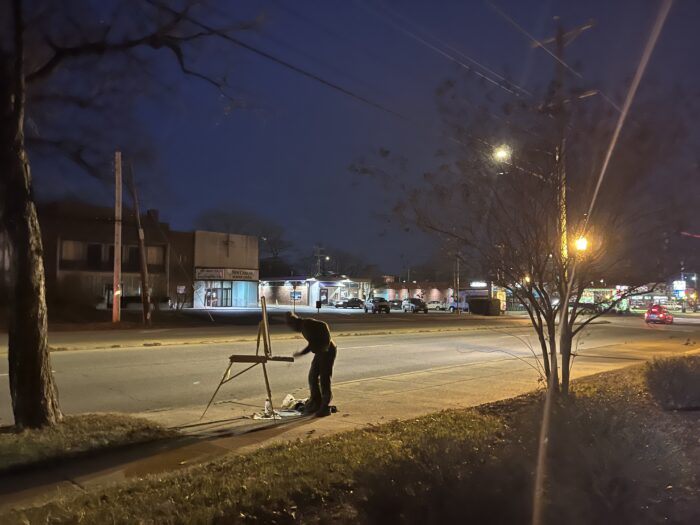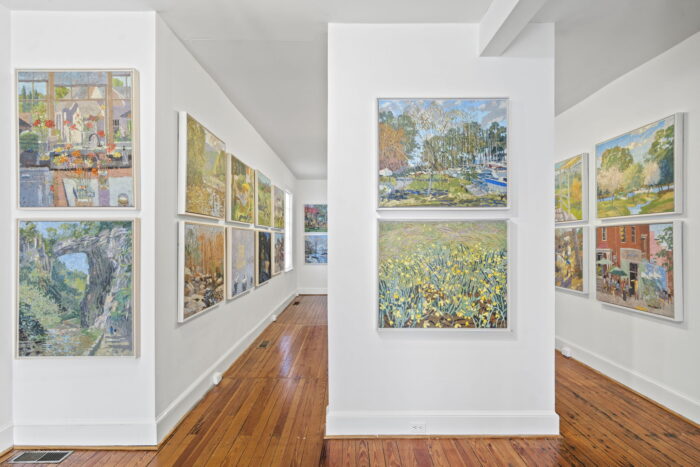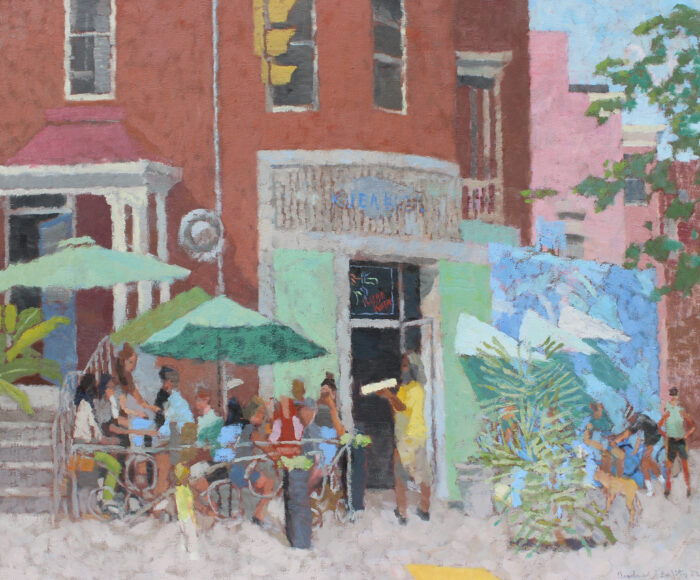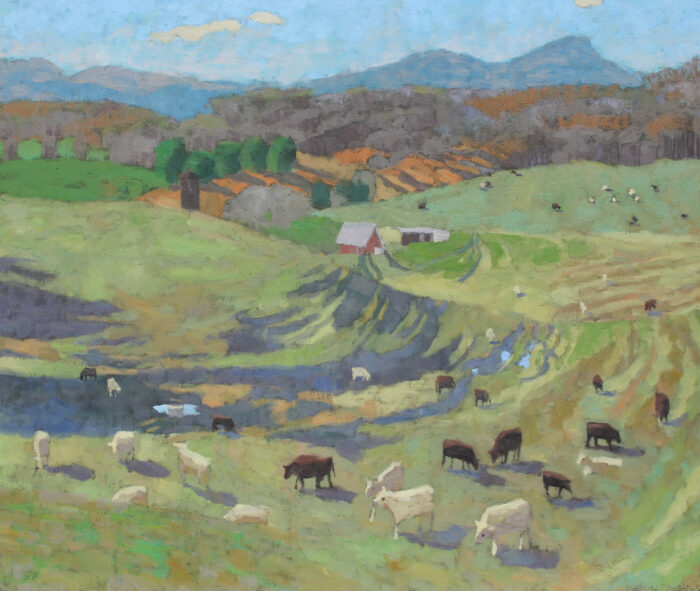So it can’t be said that I buried my lede, let’s cut to the chase: The 53 sizable oil paintings that make up “Andras Bality: Terroir,” an exhibition at the Reynolds Gallery on West Main Street, provide the viewer not only an accessible, engaging and joyous experience, but collectively represent a stunning tour de force by the artist.
Each week for 53 consecutive weeks until this season, Bality completed a substantial representational painting (each canvases was about 32″x 38″). The subjects he chose were everyday settings in unremarkable places locally, throughout Virginia, and beyond. Granted, Natural Bridge in Rockbridge County, the recently restored Jefferson Baths at Warm Springs in Bath County, or a field of daffodils in Gloucester County are hardly unremarkable. But they, and the closer-to-home Huguenot Bridge, Kuba Kuba restaurant in the Fan, and the James River rapids – as depicted with Bality’s unflinching eye, mind and hand – aren’t just reassuringly familiar, but powerfully vital. His spontaneous and naturalistic works entice us to see, feel and, even occasionally, dream as he does.
The similarly sized, brilliantly colorful canvases are double and triple hung, salon-style, in the intimate Reynolds gallery spaces, thus making the viewing experience a bit of a workout, but rewardingly so.
Some background: Early during the pandemic lockdown, Bality, a veteran and highly regarded Richmond-based artist, now 59, found himself leafing through some coffee-table art books that he’d seldom perused. A Vincent Van Gogh tome caught his attention, especially its description of how the impressionist master worked out-of-doors, usually painting many canvases the same size. Bality asked himself, why not do something similar – but on a schedule, say two canvases a week?
You guessed it, he soon eased up and aimed for one canvas weekly.
Bality’s wanderings took him not just to nearby places, such as the James River Park System, the Hanover County airport, Stingray Point in Middlesex County, but places farther afield like Monhegan Harbor, Maine. But this exhibition isn’t a travel log. Each painting describes a complete world, or state of mind, on its own visual merits. The works are meditations on the beauty, simplicity and rewards of the everyday.
One canvas captures dozens of cows on a hillside, another shows goats munching an overgrown plot of land. In “Valor” he makes dessert of a random, behind-the-house scene with a boat stowed under a sloping-roofed shed, some random lawn chairs and a cleaning rag hung on a sawhorse. Such scenes fill our days. Bality chose the term “Terroir” for the exhibition because it refers to the winemaker’s term for the qualities of the land that produce the grape.
With an assured and recognizable brushstroke, Bality mines the play of light and shadow like an engineer. A graduate of the Virginia Commonwealth University painting and printmaking department, he later studied at Cyprus College of Art in Lempa on the Mediterranean island of Cyprus. He has been described as a modern-day impressionist because of his attraction to the outdoors, loose application of mixed paint and fearlessness of color. In addition to Van Gogh, he cites the French Impressionist Pierre Bonnard as an influence. For me his works conjure two prominent 20th-century American artists, Geri Melchers (1860-1932) and Fairfield Porter (1907-1975).
Melchers, a Detroit-born and Paris- and Dusseldorf-trained artist, lived near Fredericksburg, Virginia, from 1916 until his death. He painted in a conservatively impressionist manner but feasted on the immediate world surrounding him for his subject matter (his artist wife, Corinne Melchers, was one of the 10 founders of the Virginia Museum of Fine Arts in 1933).
Fairfield Porter was a son of privilege, a fine arts graduate of Harvard who studied at the Art Students League in New York City. He painted domestic scenes of his comfortable domestic adult life in Southampton, New York. While Porter was often challenged, if not criticized, by New York-centric abstract expressionist contemporaries such as Jackson Pollock and Willem de Kooning for being representational, one critic wrote admiringly that Porter “found the extraordinary in everyday life.”
Bality has told me that he too, throughout his career, has been similarly challenged by fellow artist friends. But he is unflinching: “I believe that if we all spent a little more time outside, looking, talking, sitting on the porch, it would be good for the planet.”
You’ve got to love this guy. And wait ’til you see his paintings.

The artist at work outside Little Nickel, a Forest Hill Avenue restaurant that was another of his subjects.
“Andras Bality: Terroir” and “Carlton Newton and Esther Ruiz: Shapes in Space” continue through April 28 at the Reynolds Gallery, 1514 W. Main St.
So it can’t be said that I buried my lede, let’s cut to the chase: The 53 sizable oil paintings that make up “Andras Bality: Terroir,” an exhibition at the Reynolds Gallery on West Main Street, provide the viewer not only an accessible, engaging and joyous experience, but collectively represent a stunning tour de force by the artist.
Each week for 53 consecutive weeks until this season, Bality completed a substantial representational painting (each canvases was about 32″x 38″). The subjects he chose were everyday settings in unremarkable places locally, throughout Virginia, and beyond. Granted, Natural Bridge in Rockbridge County, the recently restored Jefferson Baths at Warm Springs in Bath County, or a field of daffodils in Gloucester County are hardly unremarkable. But they, and the closer-to-home Huguenot Bridge, Kuba Kuba restaurant in the Fan, and the James River rapids – as depicted with Bality’s unflinching eye, mind and hand – aren’t just reassuringly familiar, but powerfully vital. His spontaneous and naturalistic works entice us to see, feel and, even occasionally, dream as he does.
The similarly sized, brilliantly colorful canvases are double and triple hung, salon-style, in the intimate Reynolds gallery spaces, thus making the viewing experience a bit of a workout, but rewardingly so.
Some background: Early during the pandemic lockdown, Bality, a veteran and highly regarded Richmond-based artist, now 59, found himself leafing through some coffee-table art books that he’d seldom perused. A Vincent Van Gogh tome caught his attention, especially its description of how the impressionist master worked out-of-doors, usually painting many canvases the same size. Bality asked himself, why not do something similar – but on a schedule, say two canvases a week?
You guessed it, he soon eased up and aimed for one canvas weekly.
Bality’s wanderings took him not just to nearby places, such as the James River Park System, the Hanover County airport, Stingray Point in Middlesex County, but places farther afield like Monhegan Harbor, Maine. But this exhibition isn’t a travel log. Each painting describes a complete world, or state of mind, on its own visual merits. The works are meditations on the beauty, simplicity and rewards of the everyday.
One canvas captures dozens of cows on a hillside, another shows goats munching an overgrown plot of land. In “Valor” he makes dessert of a random, behind-the-house scene with a boat stowed under a sloping-roofed shed, some random lawn chairs and a cleaning rag hung on a sawhorse. Such scenes fill our days. Bality chose the term “Terroir” for the exhibition because it refers to the winemaker’s term for the qualities of the land that produce the grape.
With an assured and recognizable brushstroke, Bality mines the play of light and shadow like an engineer. A graduate of the Virginia Commonwealth University painting and printmaking department, he later studied at Cyprus College of Art in Lempa on the Mediterranean island of Cyprus. He has been described as a modern-day impressionist because of his attraction to the outdoors, loose application of mixed paint and fearlessness of color. In addition to Van Gogh, he cites the French Impressionist Pierre Bonnard as an influence. For me his works conjure two prominent 20th-century American artists, Geri Melchers (1860-1932) and Fairfield Porter (1907-1975).
Melchers, a Detroit-born and Paris- and Dusseldorf-trained artist, lived near Fredericksburg, Virginia, from 1916 until his death. He painted in a conservatively impressionist manner but feasted on the immediate world surrounding him for his subject matter (his artist wife, Corinne Melchers, was one of the 10 founders of the Virginia Museum of Fine Arts in 1933).
Fairfield Porter was a son of privilege, a fine arts graduate of Harvard who studied at the Art Students League in New York City. He painted domestic scenes of his comfortable domestic adult life in Southampton, New York. While Porter was often challenged, if not criticized, by New York-centric abstract expressionist contemporaries such as Jackson Pollock and Willem de Kooning for being representational, one critic wrote admiringly that Porter “found the extraordinary in everyday life.”
Bality has told me that he too, throughout his career, has been similarly challenged by fellow artist friends. But he is unflinching: “I believe that if we all spent a little more time outside, looking, talking, sitting on the porch, it would be good for the planet.”
You’ve got to love this guy. And wait ’til you see his paintings.

The artist at work outside Little Nickel, a Forest Hill Avenue restaurant that was another of his subjects.
“Andras Bality: Terroir” and “Carlton Newton and Esther Ruiz: Shapes in Space” continue through April 28 at the Reynolds Gallery, 1514 W. Main St.





